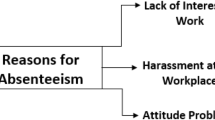Abstract
In today’s dynamic environment, an appropriate performance evaluation method for industries is a complex problem considering its funding scale. Performance evaluation in present industries has become a key part of the strategic approach. Existing performance evaluation approaches are based on manual estimations. These are prone to bias and nepotism, and hence, these manual evaluation schemes may demotivate the employees. In order make this evaluation solely performance oriented, the authors have proposed a neuro-fuzzy-based framework. For detecting and tracking the employee activities, Internet of things (IoT)–enabled sensors are used, while artificial neural fuzzy inference system (ANFIS) is used for learning and automated decision optimization. With an accuracy rate of 94.7% and an estimated RMSE error value of 0.0717, the proposed framework is fit for adaption in any real-life industrial scenario.









Similar content being viewed by others
Explore related subjects
Discover the latest articles, news and stories from top researchers in related subjects.References
Ahmed I, Sultana I, Paul SK, Azeem A (2013) Employee performance evaluation: a fuzzy approach. Int J Product Perform Manag 62(7):718–734
Hui L, Qin-xuan G (2009) Performance appraisal: what’s the matter with you? Procedia Earth and Planetary Science 1(1):1751–1756
Ranjan R, Mishra U (2017) Impact of rewards on employee performance: a case of Indian oil corporation, Patna Region. IOSR J Bus Manag (IOSR-JBM), e-ISSN: 2278-487X, p-ISSN: 2319–7668. Ver. II 19(6):22–30
Da Xu L, He W, Li S (2014) Internet of things in industries: a survey. IEEE Trans Ind Inf 10(4):2233–2243
Fang S, Da Xu L, Zhu Y, Ahati J, Pei H, Yan J, Liu Z (2014) An integrated system for regional environmental monitoring and management based on internet of things. IEEE Trans Ind Inf 10(2):1596–1605
Tsai CW, Lai CF, Chiang MC, Yang LT (2014) Data mining for internet of things: a survey. IEEE Commun Surv Tutorials 16(1):77–97
Shekhar S, Huang Y (2001) Discovering spatial co-location patterns: a summary of results. In: Jensen CS, Schneider M, Seeger B, Tsotras VJ (eds) Advances in Spatial and Temporal Databases. LNCS 2121. Springer, Berlin, Heidelberg, pp 236–256
Yao X, Chen L, Wen C, Peng L, Yang L, Chi T et al (2018) A spatial co-location mining algorithm that includes adaptive proximity improvements and distant instance references. Int J Geogr Inf Sci:1–26
Žunić E, Djedović A, Avdagić Z (2016) Decision support system for candidates classification in the employment process based on ANFIS method. In: 2016 XI International Symposium on Telecommunications (BIHTEL). https://doi.org/10.1109/BIHTEL.2016.7775718
Jang JS (1993) ANFIS: adaptive-network-based fuzzy inference system. IEEE Trans Syst Man Cybern 23(3):665–685
Jang JSR, Sun CT, Mizutani E (1997) Neuro-fuzzy and soft computing; a computational approach to learning and machine intelligence. Prentice Hall, Englewood Cliffs, NJ
Kaur J, Kaur K (2017) A fuzzy approach for an IoT-based automated employee performance appraisal. Computers, Materials and Continua 53(1):24–38
Kaur N, Sood SK (2015) A game theoretic approach for an IoT-based automated employee performance evaluation. IEEE Syst J 11(3):1385–1394
Fragiadakis NG, Tsoukalas VD, Papazoglou VJ (2014) An adaptive neuro-fuzzy inference system (ANFIS) model for assessing occupational risk in the shipbuilding industry. Saf Sci 63:226–235
Aksoy A, Öztürk N, Sucky E (2014) Demand forecasting for apparel manufacturers by using neuro-fuzzy techniques. Journal of Modelling in Management 9(1):18–35
Warne K, Prasad G, Siddique NH, Maguire LP (2004) Development of a hybrid PCA-ANFIS measurement system for monitoring product quality in the coating industry. In Systems, man and cybernetics, 2004 IEEE International Conference on (Vol. 4, pp. 3519–3524). IEEE
Mammadova M, Jabrayilova Z (2014) Application of fuzzy optimization method in decision-making for personnel selection. Intell Control Autom 5(04):190–204
Author information
Authors and Affiliations
Corresponding author
Additional information
Publisher’s Note
Springer Nature remains neutral with regard to jurisdictional claims in published maps and institutional affiliations.
Rights and permissions
About this article
Cite this article
Dhir, K., Chhabra, A. Automated employee evaluation using fuzzy and neural network synergism through IoT assistance. Pers Ubiquit Comput 23, 43–52 (2019). https://doi.org/10.1007/s00779-018-1186-6
Received:
Accepted:
Published:
Issue Date:
DOI: https://doi.org/10.1007/s00779-018-1186-6




